#Macrospondylus bollensis
Text
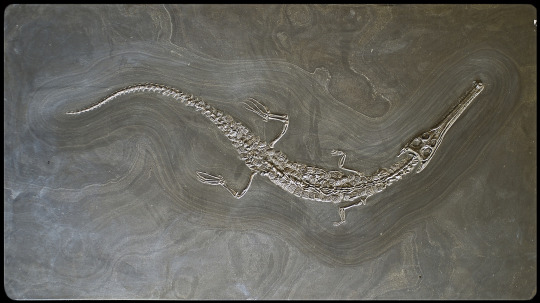
Saltwater crocodile skeleton, Macrospondylus bollensis
138 notes
·
View notes
Text
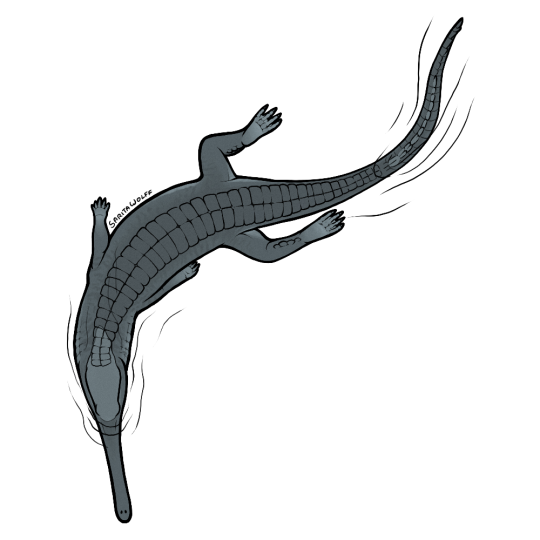
#Archovember Day 11 - Macrospondylus bollensis
The Thalattosuchians were a clade of marine pseudosuchians commonly called “marine crocodiles” or “sea crocodiles”. They were seperated into two groups, the Teleosauroids and the Metriorhynchoids. The metriorhynchoids seemed to be adapted for spending all their time in the water: they had smooth, scale-less skin, tail flukes, and even flippers. Meanwhile, teleosauroids held onto their crocodyliform nature, retaining their osteoderms and probably heading onto land when needed. They inhabited a wide range of habitats: from semi-marine coasts and estuaries, to open-ocean, to freshwater. The Early Jurassic Macrospondylus bollensis was one of these teleosauroids.
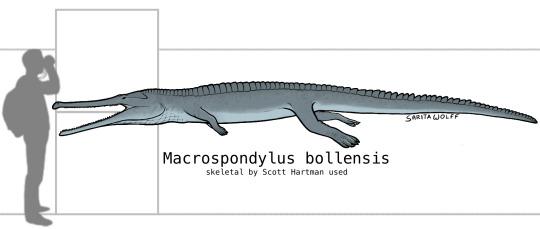
Macrospondylus bollensis, long known as “Steneosaurus bollensis” (Steneosaurus being a wastebasket taxon for thalattosuchians) finally had its genus revived in 2020. At 5.5 m (18 ft), it was the largest known Early Jurassic crocodylomorph. Like many other teleosauroids, it had a long, tapering snout, similar to its modern equivalents the gavialids. This snout would have allowed it to quickly maneuver through the water with little resistance, snapping up fish. Oddly enough, like Megalosaurus, Macrospondylus is also represented in the Crystal Palace gardens (though they are simply labeled as Teleosaurus). Modeled after gharials and based on much better preserved fossils than Megalosaurus, the teleosaur statues actually hold up pretty well, other than using a more crocodilian scute pattern.
Macrospondylus bollensis fossils have been found in Germany, the UK, and Luxembourg. It lived in the newly forming Tethys Sea, which was warm and shallow at the time, dotted with small tropical islands where Macrospondylus would have likely emerged to bask in the sun. This area is known for its fossilized crinoids, cephalopods, bivalves, crustaceans, ichthyosaurs, sharks, bony fish, and more, often exquisitely preserved “frozen in time” due to sudden events and nigh perfect fossilization factors. There was an abundance of fish here for Macrospondylus to feast upon, including chimaeras like Acanthorhina, the armoured Dapedium, the long-bodied Euthynotus, pups of the shark-like Hybodus, the herring-like Leptolepis, and many more. It would have lived alongside a variety of icthyosaurs, small plesiosaurs, other teleosauroids such as Mystriosaurus, Pelagosaurus, and Platysuchus, pterosaurs such as Campylognathoides and Dorygnathus, and come across sauropods such as Ohmdenosaurus wandering the shorelines. But Macrospondylus was not the biggest “fish” in the sea, and if it ventured into the open ocean it could have come across the 8–10 metre (26–33 ft) long icthyosaur Temnodontosaurus, the apex predator of the Early Jurassic Tethys Sea (which is also on display at the Crystal Palace!)
#my art#SaritaDrawsPalaeo#Macrospondylus#Macrospondylus bollensis#Teleosauroid#Teleosaur#Thalattosuchians#Crocodyliforms#pseudosuchians#archosaurs#archosauromorphs#reptiles#Archovember#Archovember2023
10 notes
·
View notes
Text

Day 11: Macrospondylus bollensis
#paleoart#art#dinosaur#prehistoric#paleontology#digitalart#traditionalart#Archosaur#Archovember2023#Archovember#Dinovember#Dinovember2023#DrawDinovember#DrawDinovember2023#Macrospondylus#Macrospondylusbollensis#Crocodylomorpha
146 notes
·
View notes
Text
Una nuova ricerca fa luce sugli enigmatici parenti dei coccodrilli del giurassico
Una madre di Macrospondylus bollensis tiene d’occhio i suoi piccoli.
In uno studio pubblicato sulla rivista Papers in Palaeontology, i paleontologi del Museo Statale di Storia Naturale di Stoccarda hanno analizzato i tassi di crescita di Macrospondylus bollensis, una specie di coccodrillo teleosauroide del Giurassico europeo.
Il Macrospondylus bollensis visse nell’attuale Europa durante il…

View On WordPress
0 notes
Text

Whelp we’ve got about a week and a half til November (aaaaaah), so I guess I’ll post this year’s Archovember list now!
It’s a bit dinosaur-heavy this time, but there are a lot of species I’d really like to try my hand at! Also, we have two leptoceratopsians and two Araripesuchus species. I thought it would be interesting to compare and contrast these species within the same month, so I hope it doesn’t get /too/ repetitive!
For new folks: this is my “Draw Dinovember” list that I expanded out to include other archosauriforms. I started doing this a few years ago to challenge myself to draw species I’ve never drawn before and/or ones that don’t get a lot of attention. Feel free to join in! You can do the whole list, just the dinosaurs, just the pterosaurs, just the pseudosuchians, just your favorites, just ones you’ve never drawn before, roll a D20 and a D10 and draw the sum of whichever numbers you get, etc. Just make sure they’re posted on or after their specific day so I remember to share them on my blog! You can use #Archovember or #Archovember2023, as those are the tags I follow. (Note that I and the whole Archovember event are usually a lot more active on Instagram so if you have an IG I encourage you to join in there!)
Anyway, here is the list in case the graphic is hard to read:
1. Your Choice!
2. Furcatoceratops elucidans
3. Tupandactylus navigans
4. Deinosuchus hatcheri
5. Herrerasaurus ischigualastensis
6. Lewisuchus admixtus
7. Supersaurus vivianae
8. Zhejiangopterus linhaiensis
9. Dynamosuchus collisensis
10. Megalosaurus bucklandii
11. Macrospondylus bollensis
12. Miragaia longicollum
13. Dorygnathus banthensis
14. Leptoceratops gracilis
15. Stagonolepis robertsoni
16. Shantungosaurus giganteus
17. Paleorhinus bransoni
18. Cascocauda rong
19. Kelenken guillermoi
20. Prestosuchus chiniquensis
21. Yangchuanosaurus shangyouensis
22. Istiodactylus latidens
23. Kunbarrasaurus ieversi
24. Araripesuchus wegeneri
25. Tylocephale gilmorei
26. Ixalerpeton polesinensis
27. Udanoceratops tschizhovi
28. Tapejara wellnhoferi
29. Araripesuchus rattoides
30. Scutellosaurus lawleri
One last note, and a warning I usually issue to new paleoartists: while looking for references for these species you’ll come across David Peters. His references tend to dominate search results when looking for less well-known species. They are also highly inaccurate, even the skeletals. So make sure you omit “The Pterosaur Heresies” and “Reptile Evolution” from your google search. If you have issues finding references, let me know and I can share what I’m using!
#my art#Archovember#Archovember2023#SaritaDrawsPalaeo#dinosaurs#pterosaurs#pseudosuchians#archosaurs#archosauriforms
56 notes
·
View notes
Text
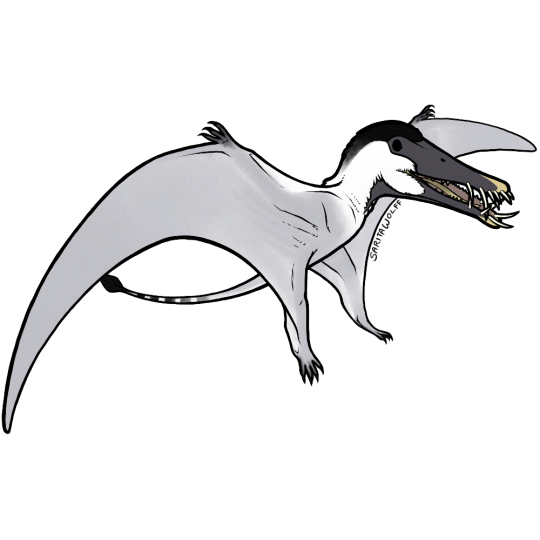
#Archovember Day 13 - Dorygnathus banthensis
Dorygnathus banthensis was a rhamphorhynchid that lived in the Early Jurassic of Europe, also in the time of the early Tethys Sea taking up most of the continent. (I did not realize I had put so many of these Jurassic archosaurs this close together when I made this list! We’ll be getting something from the Cretaceous tomorrow, don’t worry.) Like other rhamphorhynchids, it had a short neck, a long tail, and large interlocking fangs for catching and gripping wriggling fish. Wear on the teeth of some specimens suggest that they may have also fed on hard-shelled prey like mollusks and crustaceans. One specimen also contains preserved hairs, further evidence of pycnofibers or feathers in all pterosaurs.
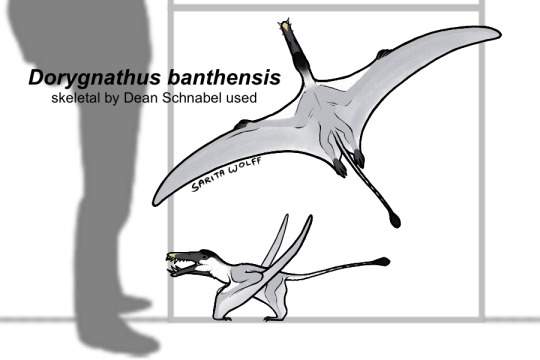
Dorygnathus was more common in its environment than its contemporary Campylognathoides, and both have been found in marine deposits suggesting they regularly traveled over open sea. Dorygnathus would have lived alongside our previously visited Macrospondylus bollensis as well as other teleosauroids like Mystriosaurus, Pelagosaurus, and Platysuchus. It would have come across sauropods like Ohmdenosaurus, and flown over the variety of Early Jurassic ocean life like icthyosaurs, small plesiosaurs, early sharks, ammonites, and much more.
#my art#SaritaDrawsPalaeo#Dorygnathus banthensis#Dorygnathus#Rhamphorhynchid#pterosaurs#archosaurs#archosauromorphs#Archovember#Archovember2023
21 notes
·
View notes